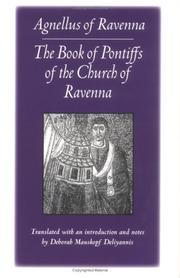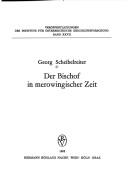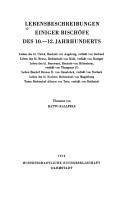| Listing 1 - 10 of 186 | << page >> |
Sort by
|

ISBN: 081321582X 9780813215822 0813213584 9780813213583 9780813213576 0813213576 9780813213583 0813213576 Year: 2004 Publisher: Washington, D.C. Catholic University of America Press
Abstract | Keywords | Export | Availability | Bookmark
 Loading...
Loading...Choose an application
- Reference Manager
- EndNote
- RefWorks (Direct export to RefWorks)
Bishops --- Archbishops --- Clergy --- Major orders --- Metropolitans --- Orders, Major --- Chaplains, Bishops' --- Episcopacy --- Catholic Church. --- Catholic Church --- Ravenna (Italy : Archdiocese : Catholic Church)

ISBN: 3205085337 9783205085331 Year: 1983 Volume: 27 Publisher: Wien Böhlaus
Abstract | Keywords | Export | Availability | Bookmark
 Loading...
Loading...Choose an application
- Reference Manager
- EndNote
- RefWorks (Direct export to RefWorks)
Christian church history --- anno 500-799 --- Bishops --- Evêques --- History --- Histoire --- -Archbishops --- Clergy --- Major orders --- Metropolitans --- Orders, Major --- Chaplains, Bishops' --- Episcopacy --- History. --- -History --- Evêques --- Archbishops --- Bishops - History
Book
ISBN: 0521229502 0521087619 0511560567 0511866186 Year: 1980 Publisher: Cambridge : Cambridge University Press,
Abstract | Keywords | Export | Availability | Bookmark
 Loading...
Loading...Choose an application
- Reference Manager
- EndNote
- RefWorks (Direct export to RefWorks)
The Tudor bishops were men of power and influence within the English realm, both because they possessed spiritual authority and because they exercised lordship over great estates. This book examines their activities as temporal lords: it seeks to discover how wealthy they were and to what uses their revenues were put. Dr Heal draws upon much research undertaken by other scholars in particular dioceses and for particular prelates. The bishops possessed considerable wealth, but they had little security, for the crown effectively controlled their economic destiny, especially after the break with Rome in 1534. No study of the episcopate can therefore ignore the effects of royal policy, and this book combines an investigation into the attitudes and behaviour of the Tudor monarchs with its close examination of the fortunes of the bishops.
Bishops --- -Archbishops --- Clergy --- Major orders --- Metropolitans --- Orders, Major --- Chaplains, Bishops' --- Episcopacy --- England --- Great Britain --- Church history --- -History --- -Bishops --- History --- -England --- Arts and Humanities

ISBN: 3534014219 9783534014217 Year: 1973 Volume: 22 Publisher: Darmstadt Wissenschaftliche Buchgesellschaft
Abstract | Keywords | Export | Availability | Bookmark
 Loading...
Loading...Choose an application
- Reference Manager
- EndNote
- RefWorks (Direct export to RefWorks)
Bishops --- Evêques --- Catholic Church --- Eglise catholique --- Biography --- Biographie --- 235.3*512 --- Hagiografie--?*512 --- Archbishops --- Clergy --- Major orders --- Metropolitans --- Orders, Major --- Chaplains, Bishops' --- Episcopacy --- Biography. --- Bishops - Germany
Book
ISBN: 3161563891 9783161563898 9783161563904 Year: 2018 Volume: 471 Publisher: Tübingen Mohr Siebeck
Abstract | Keywords | Export | Availability | Bookmark
 Loading...
Loading...Choose an application
- Reference Manager
- EndNote
- RefWorks (Direct export to RefWorks)
In this study, Justin Buol analyzes the writings connected with the deaths of Ignatius of Antioch, Polycarp of Smyrna, and Pothinus of Lyons in light of earlier accounts of the noble deaths of military, political, and religious leaders from Greco-Roman literature and the Bible, which record benefits accruing to a group on account of its leader's death. The author argues that the accounts of these three bishops' martyrdoms draw upon those prior models in order to portray the bishops as dying to unite, protect, and strengthen the Church, oppose false teaching and apostasy, and solidify the teaching role of the episcopal office. Finally, by providing a foundation for Irenaeus to argue for apostolic succession, these second-century bishop martyrs also help form a lasting contribution to the growth of episcopal power. --! From publisher's description.
Christian martyrs --- Bishops --- Church history --- 235.3*7 --- 235.3*7 Martelaren --- Martelaren --- Archbishops --- Clergy --- Major orders --- Metropolitans --- Orders, Major --- Chaplains, Bishops' --- Episcopacy --- Evêques --- Martyres
Book
ISBN: 9789185252695 Year: 2009 Publisher: Göteborg : Kungliga Vetenskaps- och vitterhets-samhället,
Abstract | Keywords | Export | Availability | Bookmark
 Loading...
Loading...Choose an application
- Reference Manager
- EndNote
- RefWorks (Direct export to RefWorks)
Bishops --- Lutherans, Swedish --- Swedish Lutherans --- Archbishops --- Clergy --- Major orders --- Metropolitans --- Orders, Major --- Chaplains, Bishops' --- Episcopacy --- Wallenstråle, Martin Georg, --- Wallenstråle, martin georg (1733-1807) --- Biographies
Book
ISBN: 1351957538 135195752X 1315262266 9786613718525 1280877219 1409451011 9781409451013 0754668363 9780754668367 9781409451013 0754668339 9780754668336 9781280877216 9780754668367 9780754668336 9781315262260 9781351957519 Year: 2012 Publisher: Farnham Burlington, Vt. Ashgate
Abstract | Keywords | Export | Availability | Bookmark
 Loading...
Loading...Choose an application
- Reference Manager
- EndNote
- RefWorks (Direct export to RefWorks)
In this unique volume in the Ashgate Archbishops of Canterbury series, Jean Truax examines the pontificates of three minor archbishops: Ralph d'Escures (1114-1122), William of Corbeil (1123-1136), and Theobald of Bec (1139-1161). By presenting their biographies, careers, thought and works as a unified period, Truax highlights crucial developments in the English church during the period of their pontificates from the death of Anselm to Becket.
Bishops --- Archbishops --- Clergy --- Major orders --- Metropolitans --- Orders, Major --- Chaplains, Bishops' --- Episcopacy --- Ralph, --- William, --- Theobald, --- England --- Church history --- Guillaume, --- Theobaldus, --- Tedbald, --- Thibaut,
Book
ISBN: 1139343645 110805160X Year: 1880 Publisher: Place of publication not identified : Cambridge : publisher not identified, Cambridge University Press
Abstract | Keywords | Export | Availability | Bookmark
 Loading...
Loading...Choose an application
- Reference Manager
- EndNote
- RefWorks (Direct export to RefWorks)
Gervase of Canterbury (c.1145-c.1210) was professed as a member of the cathedral priory of Christ Church, Canterbury, by Thomas Becket in 1163. His observations on both church and court matters give his work breadth, ranging from the king's authority to ecclesiastical topography. A prominent player in the notorious dispute between the monks and Archbishop Baldwin, Gervase attempted to reassert the traditional role of Christ Church as the archiepiscopal church at a time when its position was under threat. This two-volume collection, edited by the scholar William Stubbs (1824-1901) and published between 1879 and 1880, comprises Gervase's entire corpus of Latin works (with marginal notes in English). Volume 2 includes the Gesta regum, which begins with Brutus's Albion and is drawn from authorities such as Geoffrey of Monmouth; the Actus Pontificum, a series of lives of the archbishops of Canterbury until 1205; and the Mappa mundi, an unprecedented monastic topography of England.
Bishops --- Monasteries --- Cloisters (Religious communities) --- Friaries --- Church property --- Religious institutions --- Scriptoria --- Archbishops --- Clergy --- Major orders --- Metropolitans --- Orders, Major --- Chaplains, Bishops' --- Episcopacy --- Great Britain --- History
Book
ISBN: 113922588X 1108048862 Year: 2013 Publisher: Cambridge : Cambridge University Press,
Abstract | Keywords | Export | Availability | Bookmark
 Loading...
Loading...Choose an application
- Reference Manager
- EndNote
- RefWorks (Direct export to RefWorks)
William of Malmesbury (c.1090-c.1142) was a prolific historian and a trustworthy chronicler, described by Professor R. M. Thomson as 'the most learned European of his day' and 'England's greatest national and local historian since Bede'. A Benedictine monk, he spent his adult life at Malmesbury Abbey, where he assisted the Abbot in founding the library, and devoted his time to writing. The Latin text presented here, originally published in 1870 as part of the Rolls Series, is based on the manuscript at Magdalen College, Oxford. It is described with confidence by N. E. S. A. Hamilton as 'no other than Malmesbury's own autograph' - a claim which the editor backs up in his comprehensive preface. Revised and added to over a period of ten years following its completion in around 1125, this early ecclesiastical history of England is as much a historical record as a primary source in its own right.
Bishops --- History --- England --- Church history --- Archbishops --- Clergy --- Major orders --- Metropolitans --- Orders, Major --- Chaplains, Bishops' --- Episcopacy --- Angleterre --- Anglii︠a︡ --- Inghilterra --- Engeland --- Inglaterra --- Anglija --- England and Wales
Book
ISBN: 1802700285 1641893168 Year: 2022 Publisher: Arc Humanities Press
Abstract | Keywords | Export | Availability | Bookmark
 Loading...
Loading...Choose an application
- Reference Manager
- EndNote
- RefWorks (Direct export to RefWorks)
This comprehensive biography of John Vitez, an instrumental figure of the Early Renaissance, presents a complex picture of cultural, political, and religious developments in Central Europe through one man’s life. Drawing on close study of Vitez’s writings and his various political and artistic networks of influence, Tomislav Matić demonstrates the wide scope of this church leader’s involvement in late medieval Central Europe. Not only were Vitez’s writings a catalyst for the introduction of humanism across the region, he was a patron of the arts, an avid astrologer, a master diplomat, and even a kingmaker, thus central to both political and cultural developments.
Bishops --- Humanists --- HISTORY / Renaissance. --- Early Renaissance, Humanism, Hungary, Central Europe, Catholic Church, diplomacy. --- Scholars --- Archbishops --- Clergy --- Major orders --- Metropolitans --- Orders, Major --- Chaplains, Bishops' --- Episcopacy
| Listing 1 - 10 of 186 | << page >> |
Sort by
|

 Search
Search Feedback
Feedback About UniCat
About UniCat  Help
Help News
News